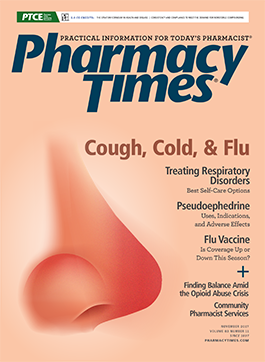Publication
Article
Pharmacy Times
When Both Drugs Are Affected
Drug–drug interactions usually occur when the drug that causes the interaction, called the precipitant or perpetrator, affects another drug, called the object or victim.
Drug—drug interactions usually occur when the drug that causes the interaction, called the precipitant or perpetrator, affects another drug, called the object or victim. Occasionally, however, the victim drug affects the perpetrator at the same time. For example, carbamazepine is metabolized by cytochrome P3A4 (CYP3A4) and is particularly sensitive to the effects of CYP3A4 inhibitors. Almost everyone on carbamazepine who starts taking a CYP3A4 inhibitor shows clinical evidence of carbamazepine toxicity. But some CYP3A4 inhibitors, such as verapamil and diltiazem, are susceptible to enzyme induction. Carbamazepine is an enzyme inducer and thus may in turn reduce the plasma concentrations of the calcium-channel blockers verapamil and diltiazem. Another example comes in the form of 2 recent case reports of interactions between cyclosporine and ticagrelor. In 1 case, there was excessive ticagrelor effect, and in the other, an excessive cyclosporine effect.
CASE REPORTS
A 58-year-old man on chronic cyclosporine treatment after a renal transplant developed life-threatening bleeding 8 days after starting therapy with ticagrelor (90 mg twice a day) for acute coronary syndrome (ACS).1 The patient’s hemoglobin fell to 4.6 g/dL, and he received 10 units of packed red blood cells. Ticagrelor is a P2Y12 receptor antagonist and acts as an antiplatelet agent in ACS and other disorders. Ticagrelor is a substrate for P-glycoprotein and CYP3A4, both of which are inhibited by cyclosporine. The cyclosporine probably increased ticagrelor plasma concentrations, as has been shown in healthy subjects. Though a cyclosporine—ticagrelor drug interaction probably caused the bleeding, the patient was also receiving atorvastatin (a weak P-glycoprotein inhibitor) and aspirin (an antiplatelet agent), both of which may have contributed. Although the authors reported that the Naranjo Adverse Drug Reaction Probability Scale gave a rating of “probable,” the more specific Drug Interaction Probability Scale (DIPS)2 gave a rating of “possible.”
In the other case report, the cyclosporine was deemed the victim of the drug interaction. A 49-year- old man stabilized on cyclosporine for several years after a renal transplant started on ticagrelor (180-mg loading dose, followed by 90 mg twice a day thereafter) and aspirin.3 Seven days after he started ticagrelor, his cyclosporine trough levels had more than doubled, and he developed several minor bleeding events. After ticagrelor was discontinued, the patient was restabilized on the previous dose of cyclosporine. The authors gave a Naranjo rating of “probable,” but using DIPS resulted in a “possible” rating.
STUDIES IN HEALTHY SUBJECTS
In a randomized 3-period crossover study, 26 healthy subjects received 3 treatments with a 2-week washout: a single 600-mg dose of cyclosporine plus a single 180-mg dose of ticagrelor, cyclosporine alone, and ticagrelor alone. The administration of cyclosporine with ticagrelor increased the ticagrelor area under the concentration time curve (AUC) by 183% and also modestly increased the AUC of the active ticagrelor metabolite, compared with values obtained following the administration of ticagrelor alone. Cyclosporine pharmacokinetics, however, was not affected by the concurrent administration of ticagrelor. This study in healthy subjects supports the first case discussed of bleeding due to cyclosporine-induced increased ticagrelor effect but does not support the second case of cyclosporine toxicity due to ticagrelor. Nonetheless, the healthy-subject study involved only single doses of cyclosporine and ticagrelor, so it is possible that a multiple-dose study would have found an interaction. Ticagrelor is generally considered a weak inhibitor of CYP3A4 and P-glycoprotein, but it is possible that this patient was particularly susceptible to this effect. Also, there was no obvious cause of the doubling of cyclosporine concentrations other than the ticagrelor.
SUMMARY
Cyclosporine and ticagrelor may be an example of interacting drugs in which both are affected. Cyclosporine appears to increase ticagrelor plasma concentrations and may lead to serious bleeding. Consider the benefit versus the risk before giving ticagrelor to a patient receiving cyclosporine. Whether ticagrelor causes cyclosporine toxicity is less well documented, and resolution must await more study.
John R. Horn, PharmD, FCCP, and Philip D. Hansten, PharmD, are both professors of pharmacy at the University of Washington School of Pharmacy. For an electronic
version of this article, including references, visit hanstenandhorn.com.
References
1. Zhang C, Shen L, Cui M, Liu X, Gu Z. Ticagrelor-induced life-threatening bleeding via the cyclosporine-mediated drug interaction. A case report. Medicine (Baltimore). 2017;96(37):e8065. doi: 10.1097/MD.0000000000008065.
2. Horn JR, Hansten PD, Chan LN. Proposal for a new tool to evaluate drug interaction cases. Ann Pharmacother. 2007;41(4):674-680.
3. van Sloten TT, de Klaver PAG, ven den Wall Bake AWL. Co-administration of cyclosporine and ticagrelor may lead to a higher exposure to cyclosporine: a case report of a 49-year-old man. Br J Clin Pharmacol. September 11, 2017. doi: 10.1111/bcp.13433.







